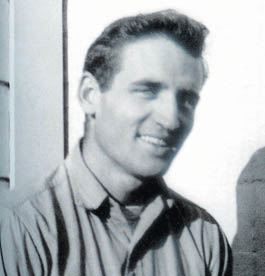home | metro silicon valley index | the arts | books | review

Photograph by Carolyn Cassady
Road Master: Neal Cassady inspired the Beats.
On the Road Again
The Beat Museum tosses a weekend-long party for beat icon Neal Cassady
By Gary Singh
WRITING in The Daybreak Boys: Essays on the Literature of the Beat Generation, Gregory Stephenson had this to say about Neal Cassady: "Dean represents an earlier American spirit (the American Adam, the American innocent) that has been stifled by what Huck Finn termed 'sivilization,' the insipid, insidious systematizing of life. ... The irony and tragedy of his situation is that there are no geographical frontiers left for him in industrial, suburban America." Most commonly remembered as the free-spirited, irrepressible, Eastern-influenced, frontier-stomping, anarcho-beatnik, goof-on-purpose hedonist who lived for the day in the most angelic way as a philosophical cosmic jester/psychopath of the most holy order, Cassady was basically the bridge between the beat writers of the '50s and the hippies of the late '60s. He was the crossover figure who simultaneously fastened together and broke apart those two eras. If you've read Jack Kerouac's On the Road, the Dean Moriarty character was based on Cassady. As if that wasn't enough, he was also immortalized in Tom Wolfe's The Electric Kool-Aid Acid Test as the guy who drove the bus for Ken Kesey's Merry Pranksters.
Sadly, Cassady passed away in 1968 on the railroad tracks in Mexico, but this weekend, the Beat Museum in San Francisco is throwing a hoedown for Neal's birthday. The weekend-long bash will feature many special guests, including Cassady's children, Jamie and John, the latter of whom still lives in the South Bay. Also making an appearance will be Neal's lifelong friend Al Hinkle, who was immortalized as Big Ed Dunkel in On the Road, so if you want to hear what it was like in 1949 when Kerouac and Cassady drove across America, you can hear it straight from the horse's mouth. Hinkle was in the back seat.
Even a quick flyover of all things Cassady would take volumes, as he weaved and bobbed his way in and out of many different realms of existence. Stephenson's analysis of the Moriarty character in On the Road goes like this: "There is, from the beginning, an element of the con artist in him, as Sal [Kerouac] recognizes, something of the self-seeking trickster, the amoral hipster looking for kicks, the young man on the make. His treatment of people often parallels his treatment of cars: using them, breaking them under the strains of his demands, and then abandoning them. Dean is alternatively innocent and demonic, tender and destructive, and Sal responds to him with admiration and with fear. [He] identifies Dean both with his 'long-lost brother' and with the Shrouded Traveler of his recurrent nightmare. He sees him both as a 'new kind of American saint' and as 'the Angel of Terror.'"
Cassady isn't usually remembered as a writer—only Kerouac and Ginsberg really considered him one—and this one passage in a 1948 letter to Kerouac not only lays down his struggles with the written word, but it also somewhat summarizes his go-for-broke attitude about life in general: "I have always held that when one writes one should forget all rules, literary styles, and other such pretensions as large words, lordly clauses and other phrases as such, i.e., rolling the words around in the mouth as one would wine and proper or not putting them down because they sound so good. Rather, I think, one should write, as nearly as possible, as if he were the first person on earth and was humbly and sincerely putting on paper that which he saw and experienced, loved and lost: what his passing thoughts were and his sorrows and desires."
THE NEAL CASSADY BIRTHDAY BASH takes place Saturday–Sunday, 10am–10pm, at the Beat Museum, 540 Broadway, San Francisco. The event features a silent auction and guest speakers. See www.thebeatmuseum.org or call 1.800.KER.OUAC for details.
Send a letter to the editor about this story.
|
|
|
|
|
|